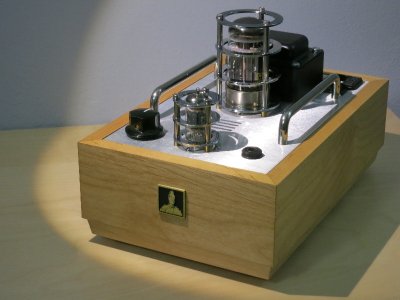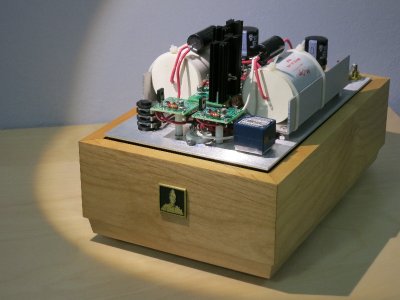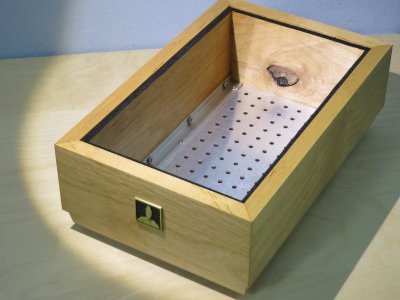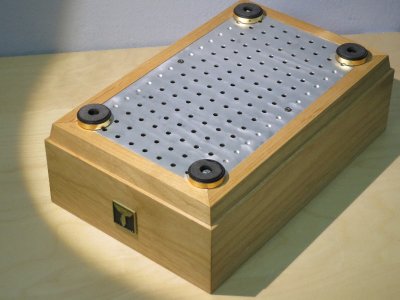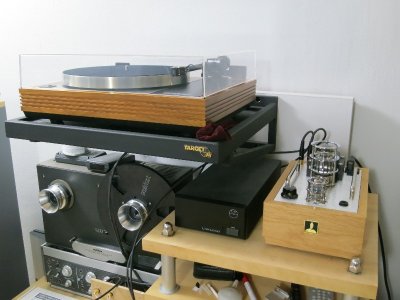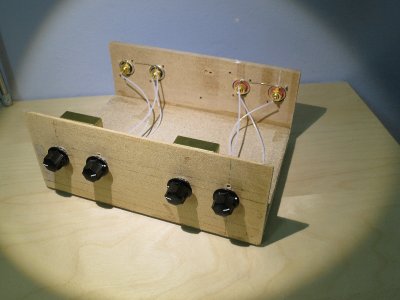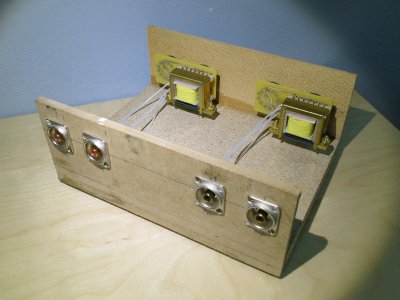Hello everybody here!
The Russian Speedball Crack has seen the light of day.
Acknowledgements
GREAT thanks to Doc B., Paul "PB" Birkeland, Paul Joppa, John Camille, Queen Eileen - excuse me if I missed somebody from your excellent team! For bringing out truly outstanding products for all music lovers and also for sharing your knowledge freely on this forum. I hope you will make few bucks in this business so that you can keep surprising us with more TUBE designs.
Project Russian Crack
I've purchased the Crack kit long ago in 2011. Then I have spent some time making the wooden cabinet, purchasing some additional parts etc. Then the project "died" for a good while, because of the house under construction, kids & family and so on... However, the last Christmas I've been kicked out for few days of holiday from my job, which was very good thing indeed! I needed two evenings to accomplish the "basic" Crack and then two more for Speedball and final adjustments.
Customization
There are few things that I've made in a slightly different way, these can be seen at the pictures.
1. The cabinet is routed to match the look of my Linn Sondek LP12 record player.
2. I added a vented a bottom cover to which the feet are attached, occasionally bought off eBay.
3. Added two handles, for more easily lifting the chassis. Underneath the handles two aluminum profiles are mounted in the same sweep to hold the output capacitors.
4. Added the tube guards. When I started the project, my kids were small. The idea was to keep them out from touching tubes of pure curiosity. When finishing the Crack the kids were old enough to understand, but I added the guards anyway, mainly for the look, but they showed to be very useful to protect the tubes when working with the amp "upside down"
5. The Alps Blue pot
6. Mundorf M-caps 100muF (large like beer cans) crossed with Mundorf Supreme 0.1muF
7. The black trim around the top of the chassis is self-adhesive felt, sometimes used for light sealing in vintage film cameras (my second hobby...) This is to provide "softer" and more dampened fit.
Looking back, I do not think the custom volume pot or the capacitors have contributed much to the sound quality, but they slow down the work for sure - you order one thing and wait for it, then you order another, wait again and so forth.
The learning from this project is this: I will build the next Bottlehead kit as is, just out of the box. It will surely save me few bucks and a lot of time, which I can enjoy listening to music. The standard kit already features VERY good component selection.
Impression of the "basic" Crack
The last tube gear I had listened to was an old kinda "radiola" at my grandmother's house.
I remember hum in the background. The damn thing was terribly "microphonic", and had a "fat" nasty sound.
This particular machine made me avoid using tube gear for coming 40 years or so.
My expectations from Crack were high, in other words.
Being a "solid state" guy in my "previous" life, I was a bit curious towards the "burning-in" phenomenon and what would it bring to the sound.
When starting up the Crack for the first time, it sounded good but for the loud music pieces... what?!! Is this a DISTORTION I hear?!! Yes, I think so...
After running for just a short time, all the strange "taste" has disappeared, however. I don't know if it were tubes or caps or maybe all together - this thing definitely needs to "burn in". At least an hour or two, before you can listen to it.
The first impression - VERY good indeed!
What surprised me most is that my heavily tweaked Project Headbox II is actually sounding not all that bad... Maybe not that advantageous conclusion for the Crack, but read on. While my moded Headbox sounds TONALY correct, the Crack clearly has THE EDGE in echoes, reverbs, spatial resolution overall. With the Crack, I just could not stop listening to the collection of Frank Sinatra on vinyl.
Impression Speedball
Simply, a great addition to basic Crack. BUT. Those of you who likes "tuby" sound might be disappointed. The Speedball surely sounds more focused, more "gathered together" and wider range but less "washed" and yes, less "TUBY".
I own few Sony classical solid state amplifiers of the period 1965-1967, and the sound of Speedball Crack brings me to an interesting observation. The best properly designed "solid state" stuff is sounding more like a tube gear, very gentle, with warmth and depth to the sound, while the best designed tube gear tend to sound less "tuby", more focused and with greater extension at the bottom-end and at the top-end, similar to the best vintage solid state gear.
Ideally (if possible at all), the best designed solid state and the best designed tube gear should approach each other in a imaginary point called "the perfect sound". But the tube gear has the LEAD anyway, since it comes from the right direction, so to say. (The development of the solid state gear goes in totally wrong direction since the early 70-s.)
Or maybe to make observations just not my cup of tea
Troubles
I've experienced no troubles assembling the Crack, thanks to excellently written manual. The Crack started at first kick, both basic and Speedball, of course after the resistance and voltage checks.
Lately, I discovered that the 6080 Philips tube from the kit was slightly microphonic. It made "scrambling" sound in the headphones when gently knocking on the tube with a nail. Later I noticed a clear level difference between the right and the left channels. Changing this tube to a NOS Sylvania 6080WB solved the problem.
Another thing that confuses me a bit is the power transformer which is getting HOT. For a "solid state" guy, hot means 120-140F/50-60C. Is this normal???
Next project
Ordered an Eros kit + IERC shields on the Leap Day 2016 offer. It is likely to replace the Linn Linto LOMC RIAA amp, depending on the listening outcome. I'll report this one later
Thanks for reading and good luck with your projects.
Best regards,
Alexei
The Russian Speedball Crack has seen the light of day.
Acknowledgements
GREAT thanks to Doc B., Paul "PB" Birkeland, Paul Joppa, John Camille, Queen Eileen - excuse me if I missed somebody from your excellent team! For bringing out truly outstanding products for all music lovers and also for sharing your knowledge freely on this forum. I hope you will make few bucks in this business so that you can keep surprising us with more TUBE designs.
Project Russian Crack
I've purchased the Crack kit long ago in 2011. Then I have spent some time making the wooden cabinet, purchasing some additional parts etc. Then the project "died" for a good while, because of the house under construction, kids & family and so on... However, the last Christmas I've been kicked out for few days of holiday from my job, which was very good thing indeed! I needed two evenings to accomplish the "basic" Crack and then two more for Speedball and final adjustments.
Customization
There are few things that I've made in a slightly different way, these can be seen at the pictures.
1. The cabinet is routed to match the look of my Linn Sondek LP12 record player.
2. I added a vented a bottom cover to which the feet are attached, occasionally bought off eBay.
3. Added two handles, for more easily lifting the chassis. Underneath the handles two aluminum profiles are mounted in the same sweep to hold the output capacitors.
4. Added the tube guards. When I started the project, my kids were small. The idea was to keep them out from touching tubes of pure curiosity. When finishing the Crack the kids were old enough to understand, but I added the guards anyway, mainly for the look, but they showed to be very useful to protect the tubes when working with the amp "upside down"
5. The Alps Blue pot
6. Mundorf M-caps 100muF (large like beer cans) crossed with Mundorf Supreme 0.1muF
7. The black trim around the top of the chassis is self-adhesive felt, sometimes used for light sealing in vintage film cameras (my second hobby...) This is to provide "softer" and more dampened fit.
Looking back, I do not think the custom volume pot or the capacitors have contributed much to the sound quality, but they slow down the work for sure - you order one thing and wait for it, then you order another, wait again and so forth.
The learning from this project is this: I will build the next Bottlehead kit as is, just out of the box. It will surely save me few bucks and a lot of time, which I can enjoy listening to music. The standard kit already features VERY good component selection.
Impression of the "basic" Crack
The last tube gear I had listened to was an old kinda "radiola" at my grandmother's house.
I remember hum in the background. The damn thing was terribly "microphonic", and had a "fat" nasty sound.
This particular machine made me avoid using tube gear for coming 40 years or so.
My expectations from Crack were high, in other words.
Being a "solid state" guy in my "previous" life, I was a bit curious towards the "burning-in" phenomenon and what would it bring to the sound.
When starting up the Crack for the first time, it sounded good but for the loud music pieces... what?!! Is this a DISTORTION I hear?!! Yes, I think so...
After running for just a short time, all the strange "taste" has disappeared, however. I don't know if it were tubes or caps or maybe all together - this thing definitely needs to "burn in". At least an hour or two, before you can listen to it.
The first impression - VERY good indeed!
What surprised me most is that my heavily tweaked Project Headbox II is actually sounding not all that bad... Maybe not that advantageous conclusion for the Crack, but read on. While my moded Headbox sounds TONALY correct, the Crack clearly has THE EDGE in echoes, reverbs, spatial resolution overall. With the Crack, I just could not stop listening to the collection of Frank Sinatra on vinyl.
Impression Speedball
Simply, a great addition to basic Crack. BUT. Those of you who likes "tuby" sound might be disappointed. The Speedball surely sounds more focused, more "gathered together" and wider range but less "washed" and yes, less "TUBY".
I own few Sony classical solid state amplifiers of the period 1965-1967, and the sound of Speedball Crack brings me to an interesting observation. The best properly designed "solid state" stuff is sounding more like a tube gear, very gentle, with warmth and depth to the sound, while the best designed tube gear tend to sound less "tuby", more focused and with greater extension at the bottom-end and at the top-end, similar to the best vintage solid state gear.
Ideally (if possible at all), the best designed solid state and the best designed tube gear should approach each other in a imaginary point called "the perfect sound". But the tube gear has the LEAD anyway, since it comes from the right direction, so to say. (The development of the solid state gear goes in totally wrong direction since the early 70-s.)
Or maybe to make observations just not my cup of tea
Troubles
I've experienced no troubles assembling the Crack, thanks to excellently written manual. The Crack started at first kick, both basic and Speedball, of course after the resistance and voltage checks.
Lately, I discovered that the 6080 Philips tube from the kit was slightly microphonic. It made "scrambling" sound in the headphones when gently knocking on the tube with a nail. Later I noticed a clear level difference between the right and the left channels. Changing this tube to a NOS Sylvania 6080WB solved the problem.
Another thing that confuses me a bit is the power transformer which is getting HOT. For a "solid state" guy, hot means 120-140F/50-60C. Is this normal???
Next project
Ordered an Eros kit + IERC shields on the Leap Day 2016 offer. It is likely to replace the Linn Linto LOMC RIAA amp, depending on the listening outcome. I'll report this one later
Thanks for reading and good luck with your projects.
Best regards,
Alexei

